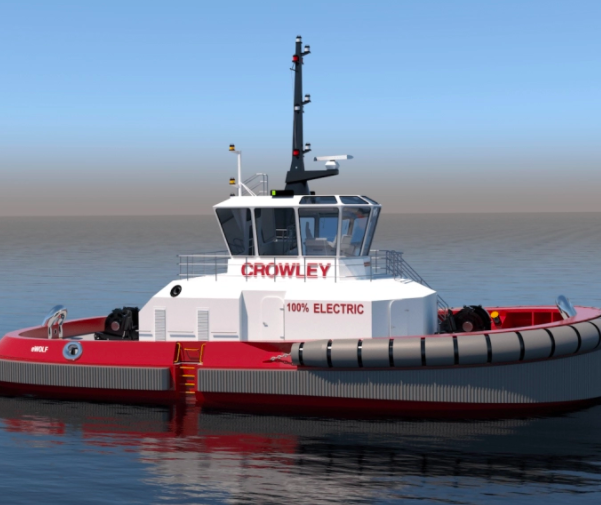
The first fully electric harbor tugboat will soon serve the Port of San Diego. Crowley Maritime Corporation will build and operate the tug, which will be operational by mid-2023. Instead of fuel, the eWolf will reportedly source its power from a 6 megawatt-hour battery bank which will be charged at a special shoreside charging station. The eWolf will replace a tugboat that consumes 30,000 gallons of diesel annually.
According to Crowley, over a 10-year period, the electric tugboat will accomplish the elimination of 178 tons of nitrogen oxide (NOx); prevent the release of 2.5 tons of diesel particulate matter; and could displace around 3,100 metric tons of carbon dioxide (CO2) that otherwise would be emitted into the atmosphere.
The 82-foot vessel will have 70 tons of bollard pull, which is an impressive amount of pulling and towing power. Harbor tugboats are critical for towing, pushing and guiding mega-ships into port. As ships grow in size, they have a difficult time having the agility required at low speeds and in tight spaces.

The size of the average container ship has doubled in the last 20 years, putting more demands on harbor tugs. As global trade continues to surge, so does the volume of goods that are passing through ports.
Maritime shipping is a vital aspect of trade and supply chains and is the lifeblood of the global economy. In fact, an estimated 90 percent of traded goods travel by ship. Although so many of the goods in our homes and offices have traveled to us by sea, including imported food, clothing, electronics, and appliances, consumers by and large don’t notice the incredible amount of logistics required to move goods from their source to our homes and offices. The incident where the Ever Given got stuck in the Suez Canal in March 2021, was a reminder of how the scale of shipping is ever increasing and the ripple effects of one bottleneck.
Ports are also a source of air pollution and greenhouse gases as ships sit idle, tugboats maneuver ships into port, and heavy-duty trucks zoom to and from the docks. As a result, neighborhoods near the Port of San Diego, such as Barrio Logan, have some of the highest diesel pollution rates in California.
These emissions are causing lung cancer, asthma, and chronic heart disease. In Barrio Logan, the asthma hospitalization rate is roughly 2.5 times the national average. The neighborhood is surrounded by numerous major sources of pollution, due in a large part to hazardous zoning regulations that allow for this mixed-use neighborhood to have residences and industry side-by-side.
Historically, communities of color have been located next to some of the most contaminated neighborhoods, resulting in grave health issues. The South Bay area near the Port of San Diego is largely comprised of low-income communities of color, raising environmental justice concerns.
These port-side neighborhoods are disproportionately saddled with the air pollution associated with global trade and North American distribution. The Port of Los Angeles has been able to significantly reduce airborne pollutants in recent years, sparking optimism.
A recent report by the California Air Resource Board for the San Diego Air Pollution Control District (SDAPCD) of preliminary health risks estimates that in the Barrio Logan and National City neighborhoods, diesel particulate matter causes 84 percent of the neighborhoods’ cancer risks. To that end, the SDAPCD seeks to adopt a visionary Community Emission Reduction Plan (CERP), which would exceed state zero-emission vehicle goals and create strategies to reduce nearby communities’ cancer risk. Although the plan is being heralded by many for promoting environmental justice and positive change, others are concerned it will take too long and that immediate action is urgently needed.
“Similar to the San Pedro Bay Port Complex and the Port of Oakland, the [port] district has relied on plans and partnerships to develop a variety of emission reduction projects and programs on port tidelands,” stated Port of San Diego district staff. “As laws, regulations, and technologies continue to change, it’s important for the district to have a broad, comprehensive and flexible strategy that helps it prioritize clean air initiatives in a manner that supports maritime business objectives.”
Although dramatically reducing pollution in nearby communities is a complex issue that largely relies on reducing truck emissions, the eWolf is clearly a step in a cleaner direction. Considering the scale of the issues at hand and the high impact on portside communities and beyond, zero-emission innovation is critical. This all-electric tugboat is a step towards a cleaner transportation industry.
Image credits: Crowley

Sarah Lozanova is an environmental journalist and copywriter and has worked as a consultant to help large corporations become more sustainable. She is the author of Humane Home: Easy Steps for Sustainable & Green Living, and her renewable energy experience includes residential and commercial solar energy installations. She teaches green business classes to graduate students at Unity College and holds an MBA in sustainable management from the Presidio Graduate School.














